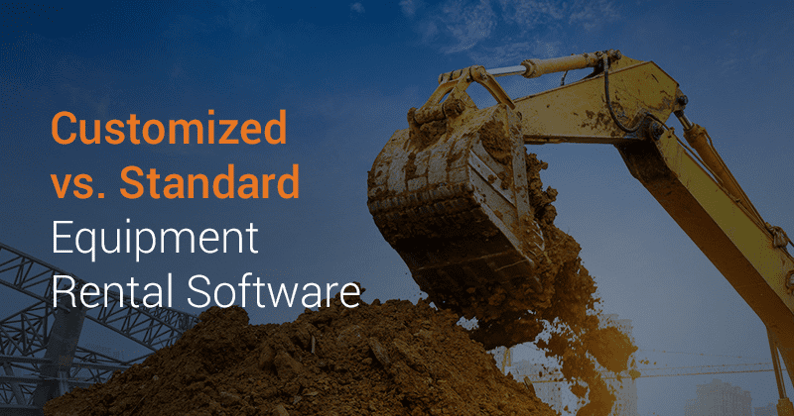Are you planning to buy a novel equipment rental software solution or replace your current one? If yes, then you will eventually have to decide whether you want to buy a standardized solution off the shelf or build a customized one yourself.
Although not easy to make a rational choice between the two, the decision can be highly consequential. Chris Doig, Waferry CEO, says in this article
“….the costs of making the wrong decision will be felt for years. On the other hand, the consequences of the right decision can resonate with the bottom line for decades or more.”
At To-Increase, we have seen that most companies struggle to choose between build and buy options either due to lack of information on the pros and cons of the two alternatives or difficulty in qualifying the information they do have, or both. While most comprehend the benefits of an equipment rental software solution, they are stuck when having to select the right one.
This blog will shed some light on this “build vs. buy” decision-making process and assist the equipment rental companies in making a well-informed decision.
The Pros and Cons of Building vs. Buying Equipment Rental Software
Firstly, it’s important we understand that the right/best decision cannot be the same for all the equipment rental companies. It is company-specific and will be based on weighing the pros and cons of the build vs. buy dilemma against a company’s objectives, available resources, culture, needs, and preferences.
Whatever your decision is right now, this in-depth comparative analysis will give you enough background to make it more rational and suitable for your business.

Here are the pros and cons of both solutions:
Pros of Building a Customized Software
- Customization: One of the biggest pros of building your own custom software solution is that it will include all the functionality you need to operate in exactly the ways you need it to. The software you end up with will be tailored to your unique business model and challenges.
- Scalability: Total control over the development allows you to add any new features when needed so that your business can continue to run like a well-oiled machine. You can start with a prototype and grow the software as your revenues grow. Additionally, your employees will be able to give their feedback on what features are essential to streamline their workflows.
- Greater control: As the sole owner of the solution, you will have full control over user options, security measures, and system updates. Plus, complete ownership gives you the option to market the product, itself, offering your software as a service down the line.
- Intellectual property: When leveraging a unique intellectual property or genuinely novel capabilities, an in-house development may be ideal—particularly if there is a plan to monetize the product via external customers.
- Faster growth: With the capability, scalability, and customization of proprietary software solutions comes the added benefit of faster and better results. Software that is customized to your workflow and optimized for today’s connected world can push production and profitability through the roof and lead to exponentially faster business growth.
- Competitive advantage: When you rely on the same off-the-shelf software as your rival does, it is that much more difficult to outperform them. By designing your own technology that is ideally suited for your specific business operations, you can garner a competitive advantage relative to your competitors. That advantage grows as you invest more heavily in your proprietary systems.
- Guaranteed integration: Building your own solution means you can ensure seamless integration with any existing software, tools, and processes already in use.
Cons of Building a Customized Software
- Significant upfront cost: Like anything that is customized, a custom solution will cost more than an off-the-shelf product. However, off-the-shelf solutions may not always be the most economically feasible route in the long run. Over time, the use of pre-built software can create a loss of revenue due to the lack of scalability or critically essential functionality. You’ll want to ensure that the revenue your business generates can comfortably cover the costs of building, maintaining, and upgrading custom software.
- Time to build: It takes time to identify your organization’s workflow processes and develop the software that optimizes them. You must be prepared to spend time gathering this information so that a custom solution will be appropriate and powerful for your business.
- Expense: A custom software needs maintenance, which adds to the cost. However, keep in mind that, over time, the use of a pre-built software can create a loss of revenue that far exceeds the additional cost of maintaining a custom software. This is because pre-built software often eats up valuable time and resources from your business as your employees do their best to compensate for not having all the features they need to run optimally.
- Scope creep risk: There is a risk of continuous or uncontrolled growth in a project's scope, at any point after the project begins. This can occur when the scope of a project is not properly defined, documented, or controlled. Consequently, developers create all kinds of functionalities as requested by the (end or key) users, without qualifying these requirements. This usually leads to a project tremendously exaggerating all its timings and budgets, and resulting in a fragmented end-solution, which works perfectly for every single user, but not as an integrated system anymore.
Pros of Buying a Pre-built Software
- Lower upfront cost: If cost is a major concern and you have limited resources to launch, a pre-built software maybe your best option since it is typically cheaper to buy and implement.
- Faster implementation: Since it doesn’t need to be built, off-the-shelf software can get up and running faster. However, allow us to dispel the common myth that launching a pre-built business software doesn’t require extensive IT involvement. Despite the convenience that is implied with the term “off-the-shelf,” these aren’t your typical plug-and-go type of solutions. Smooth and successful implementation of pre-built software often takes time and technical expertise.
- Updates, new features, and ongoing maintenance: Third-party providers will want to stay competitive. Therefore, apart from keeping up with maintenance, a third-party solution will often be updated regularly with new features and functionality.
- Lack of technical proficiency: If you do not have a strong software team skilled enough to build out this custom software, it would be wise to pass on the opportunity until you do have such a team in place. If you cannot hold your software developers accountable for such a project, it will be tough to create great or even the right products.
- Availability of great canned software: Generally, you will find well-proven canned software solutions available that fit your organization’s purpose effectively.
Cons of Buying a Pre-built Software
- Less customization: While many third-party software solutions enable some level of customization, the solution won’t be entirely custom-built for you. This means you are stuck with pre-defined functionalities, some of which may not even be useful for you.
- Less control: The vendor controls the solution’s updates, volume capacity, and functionalities. All the key decisions on the software’s features and future are out of your hands.
- Compatibility and connectivity issues: Pre-built software may not be compatible with other programs, devices, or products that you are using today—or with solutions you may need to implement in the future.
- Non-scalable: Canned solutions generally address many of the needs of most If your business has specialized needs, you may need a custom software to be able to scale up with your changing needs.
- Long-term cost: Although ready-made software may be cheaper to buy initially, its costs may grow over time. Subscriptions and licenses tend to be time-limited, so you'll have to reinvest whenever they run out. What’s more, if your company grows significantly, you will have to add more licenses for new employees.
How to Decide between the Two?
Having learned the pros and cons of building vs. buying an equipment rental software solution, the next question you may have is, ‘How do I get down to making that decision?’
Begin by making a list of your requirements, needs, and preferences related to:
- Control
- Monetary costs
- Maintenance
- Opportunity costs
- Time-to-Value
Rate these factors by importance for your organization and evaluate their pros and cons to conclude which option is a better fit for your business: building or buying an equipment rental software solution. And, once you are clear with what your business needs, you can also consider looking at the key features of an ideal equipment rental software.
A customized solution can bring you the best of both worlds. However, if you still need to go a level deeper, there is a grey area that serves as another option. And, that is to buy a standard solution and modify it into a hybrid in the following two ways:
- Building or developing what is missing in the purchased standard solution selected
- Buying an additional best-of-breed solution along with a standard solution and integrating them
If you want to discuss your questions on how to take the next step or learn how DynaRent, a comprehensive equipment rental solution, can bring your business up to speed, you can talk to our industry expert. They can help you analyze your requirements and guide you in selecting the right solution for your business.

.png)



